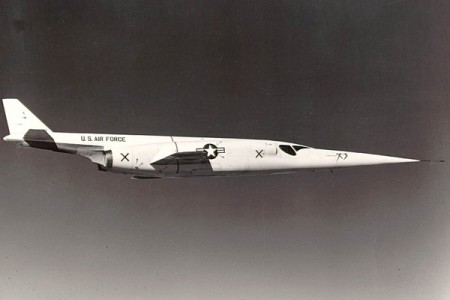
Fifty-nine years ago this month, the USAF/Douglas X-3 Stiletto research aircraft encountered a then little known dynamic instability during a flight test that nearly ended in disaster. NACA test pilot Joseph A. Walker was at the controls of the needle-nosed experimental aircraft.
The X-3 was designed to fly at speeds up to Mach 2. The aircraft was approximately 67 feet in length and had a wing span on the order of 23 feet. Gross weight was 23,840 pounds.
A pair of Westinghouse J46-WE-1 turbojets were intended to power the X-3. However, protracted developmental problems and installation issues with these powerplants would eventually prevent their use in the aircraft.
The X-3 was ultimately outfitted with a pair of Westinghouse J34-WE-17 turbojets. The result was that the X-3 was now underpowered and could barely fly supersonically. Maximum achieved Mach number was 1.21 and that was in a 30-deg dive!
Notwithstanding the above, the X-3 took to the air 54 times between October 1952 and May 1956 for the purpose of conducting transonic flight research. It would be on its 43rd flight that the X-3 would make its most important contribution to aviation.
On Wednesday, 27 October 1954, Joe Walker took-off in the X-3 (S/N 49-2892) from Edwards Air Force Base, California. At Mach 0.92 and 30,000 feet, Walker applied left aileron at fixed-rudder in an effort to develop a rapid roll response. To Walker’s utter amazement, the X-3 went wild in both pitch and yaw.
Although it seemed to last much longer, Walker was able to recover control of the X-3 within 5 seconds of his initial left aileron input. In true test pilot fashion, Walker again made an abrupt rudder-fixed left aileron input at Mach 1.05. The same thing happened. However, this time the aircraft’s motions were more violent.
Happily, Walker again recovered control of the X-3. Having had enough of flight test frontiersmanship for one day, Walker uneventfully recovered the aircraft to Edwards.
The phenomenon that Joe Walker and the X-3 encountered that day in 1954 is known as Inertial Roll Coupling. It is a resonant divergence in either pitch or yaw due to the presence of roll rate. Aircraft like the X-3, which have low longitudinal and/or directional static stability as well as high pitch-to-roll and yaw-to-roll moment of inertia ratios, are especially susceptible to this phenomenon.
As a postscript to our story, the phenomenon of Inertial Roll Coupling had been hypothesized by the NACA’s William H. Phillips back in June of 1948. For Joe Walker in October of 1954, engineering theory would become flight test fact in a few terrifying seconds high in the skies over Edwards Air Force Base.
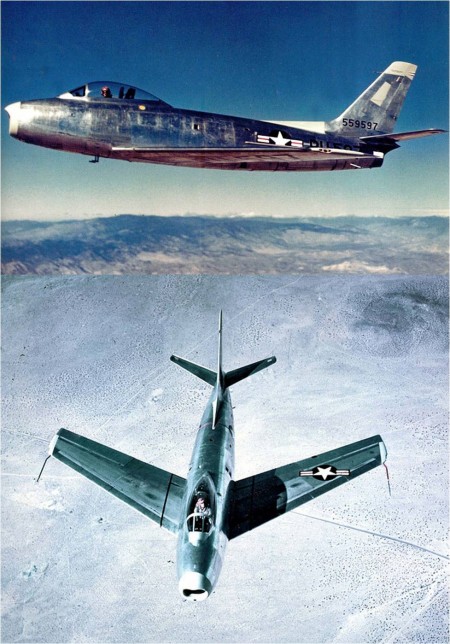
Sixty-three years ago this month, a United States Air Force aircraft broke the storied sound barrier for the first time. While the rocket-powered Bell XS-1 is credited in the history books for this achievement, there is ample and compelling evidence that the North American XF-86 Sabre was in fact the first aircraft to exceed Mach One.
October 1947 was a pivotal time in the history of aviation. For it was in that very month and year that a piloted aircraft first safely exceeded the speed of sound. This feat was accomplished by a United States Air Force aircraft, flown by a World War II combat ace, in the skies over a remote desert air base in California.
The common understanding is that (1) the aircraft involved was the Bell XS-1, Ship No. 1 (S/N 46-062), (2) piloted by Captain Charles E. “Chuck” Yeager at (3) Muroc Army Airfield, California. It is a verifiable fact that said aircraft and pilot indeed flew supersonically on Tuesday, 14 October 1947 at the aforementioned location. However, this occasion did not necessarily mark the first time that the sonic wall was successfully penetrated.
While anathema to some, it is averred here that the aircraft that first safely achieved supersonic flight was the North American XF-86 Sabre, Ship No. 1 (S/N 45-59597). This was accomplished with the aircraft in a dive. The pilot of that aircraft was North American test pilot and former Air Force fighter pilot George Schwartz “Wheaties” Welch. Welch exceeded Mach 1 on at least two dates in October of 1947. In particular, the 1st and the 14th of that month.
If you are looking for the official flight records that substantiate the assertions above, you will be disappointed. However, if you are willing to ponder the available anecdotal and circumstantial accounts submitted by numerous eye and earwitnesses, you may want to consider reading the 1998 book entitled “Aces Wild: The Race to Mach 1” by engineering test pilot Albert W. “Al” Blackburn.
I won’t spoil your fun here in delving into Blackburn’s writings. However, suffice it to say that the author’s case is persuasive. And Blackburn, who passed away in 2011, knew whereof he spoke. As an accomplished and respected aviation veteran, he graduated from MIT with a masters degree in Aeronautical Engineering and defended freedom from the air in both World War II and the Korean War.
Al Blackburn flew as a test pilot for the United States Navy at the Naval Air Test Center in Patuxent River, Maryland. Later, he became an engineering test pilot for North American Aviation in Los Angeles, California. Among many distinctions, Al Blackburn made the first flight in the F-100 Zero Length Launch (ZEL) Program. He also served as the third president of the Society of Experimental Test Pilots (SETP).
If you get the feeling that I’m trying to validate Al Blackburn and thus his story about the first to achieve Mach 1, you would be right! That’s because you will hear other voices, some of high aeronautical repute, who vehemently disagree with Blackburn. However, at least in this writer’s view, the collective contentions of the anti’s are easily challenged and ultimately fail to persuade.
While Chuck Yeager is still with us, George Welch is not. He sadly and needlessly perished at the ripe old age of 36 in an infamous F-100A Super Sabre mishap in 1954. However, to the end of his life, Welch steadfastly (and with absolutely no notoriety) maintained that he was indeed the first to Mach 1. For his part, Chuck Yeager is understandably among the naysayers when the topic of Welch being the first to achieve Mach 1 is raised.
After you consider the case presented by Al Blackburn in “Aces Wild”, perhaps you will agree with me that the historical record should be amended to read: Chuck Yeager and the Bell XS-1 were the first to exceed Mach 1 in level flight. George Welch and the North American XF-86 was the first to exceed Mach 1; which exceedance was accomplished in a dive.
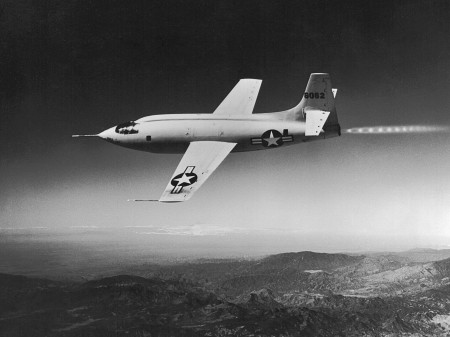
Sixty-six years ago this week, the USAF/Bell XS-1 rocket-powered experimental aircraft exceeded the speed of sound when it reached a maximum speed of 700 mph (Mach 1.06) at 45,000 feet.
Bell Aircraft Corporation of Buffalo, New York built three (3) copies of the XS-1 under contract to the United States Army Air Forces (USAAF). These aircraft were designed to approach and then fly beyond the speed of sound.
The Bell XS-1 measured 31-feet in length and had a wing span of 28 feet. Gross take-off weight tipped the scales at around 12,500 lbs. The XS-1 had an empty weight of about 7,000 lbs. Propulsion was provided by a Reaction Motors XLR-11 rocket motor capable of generating a maximum thrust of 6,000 lbs at sea level.
On the morning of Tuesday, 14 October 1947, the XS-1 (S/N 46-062) dropped away from its B-29 mothership (S/N 45-21800 ) as the pair flew at 220 mph and 20,000 feet. In the XS-1 cockpit was USAAF Captain and World War II ace Charles E. Yeager. The young test pilot had named the aircraft Glamorous Glennis in honor of his wife.
Following drop, Yeager sequentially-lit all four XLR-11 rocket chambers during a climb and push-over that ultimately brought him to level flight around 45,000 feet. The resulting acceleration profile propelled the XS-1 slightly beyond Mach 1 for about 20 seconds. Yeager then shutdown the rocket, decelerated to subsonic speeds, and landed the XS-1 on Muroc Dry Lake at Muroc Army Airfield, California.
The world would not find out about the historically-significant events of 14 October 1947 until December of the same year. As it was, the announcement came from a trade magazine that even today is sometimes referred to as “Aviation Leak”.
Today, Glamorous Glennis is prominently displayed in the Milestones of Flight hall of the National Air and Space Museum located in Washington, DC. For his efforts in breaking the sound barrier, Chuck Yeager was a co-recipient of the 1948 Collier Trophy.
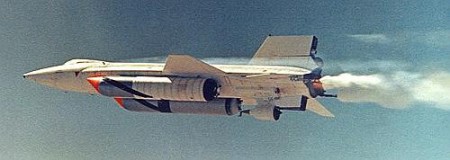
Forty-six years ago this month, USAF Major William “Pete” Knight piloted the fabled USAF/North American X-15A-2 hypersonic research aircraft to a record speed of 4,520 mph – about a mile and a quarter per second.
North American’s original X-15 production run consisted of three (3) aircraft. The X-15A-2 was a rebuild of the 2nd airframe (S/N 56-6671) which had been severely damaged during an emergency landing at Mud Lake, Nevada in November of 1962.
The rebuilt aircraft was configured with a pair of droppable propellant tanks that allowed the type’s XLR-99 rocket engine to operate 60 seconds beyond the stock X-15′s 80-second burn time. Among other modifications, the aircraft also carried a pylon-mounted dummy ramjet in the ventral region of the aft fuselage.
With the addition of the external propellant tanks, the X-15A-2 was really a three-stage vehicle. The first stage was the NASA NB-52B mothership which launched the X-15 at Mach 0.82 and 45,000 feet. The second stage consisted of the propellant-laden external tanks which were jettisoned at Mach 2.0 and 70,000 feet. The third stage was the X-15A-2 with its entire internal propellant load.
Due to the increased speed of the X-15A-2, the aircraft was covered with Martin MA-25S ablator to protect it from the higher aerodynamic heating loads. The baseline ablator was pink in color and gave the X-15A-2 a rather odd appearance. Fortunately, application of a white wear/sealer over the ablator gave the aircraft a more dignified look.
On Tuesday, 03 October 1967, Pete Knight and the X-15A-2 dropped away from the NB-52B (S/N 52-008) at the start of the X-15 Program’s 188th mission. Knight ignited the XLR-99 rocket engine and executed a pull-up followed by a pushover to level flight at a little over 102,000 feet. Aircraft speed at XLR-99 burnout was 4,520 mph (Mach 6.7).
As the aircraft decelerated following burnout, Knight executed a series of pre-planned flight maneuvers to acquire vital aerodynamics data. However, passing through Mach 5.5, he received an indication in the cockpit that a high temperature condition existed in the XLR-99 engine bay.
Knight attempted to jettison the aircraft’s remaining propellants, but to no avail. The jettison tubes were welded shut by whatever was going on back in the engine bay. This meant he would land heavier and faster than usual. Fortunately, Knight’s piloting skills allowed him to get the X-15A-2 on to Rogers Dry Lake in one piece.
As flight support personnel inspected the X-15A-2 airframe following Knight’s emergency landing, they were alarmed at what they found. The aft ventral region of the aircraft had incurred significant thermal damage. Further, the dummy ramjet was gone.
As reported in the classic technical report, NASA TM-X-1669, much higher-than-expected aerodynamic heating levels were responsible for the damage to the X-15A-2 airframe.
First, shock wave/boundary layer interaction heating on the lower fuselage just ahead of the pylon (1) completely destroyed the ablator in that region and (2) penetrated the Inconel-X airframe structure. This introduced very high temperature air into the X-15 engine bay.
Second, impingement of the dummy ramjet nose shock on the detached bow shock coming off of the pylon produced a shear layer that focused on the pylon leading edge. The resulting heating rates were of sufficient magnitude and duration to both burn away the pylon ablator and burn through the pylon structure. The weakened pylon attachment eventually failed and the dummy ramjet departed the main airframe.
Pete Knight will forever hold the record for the fastest X-15 flight. However, the X-15A-2 never flew again. Only 11 more flights remained in the X-15 Program at the time. A lack of time and funding meant that little was to be gained by repairing the thermally-damaged aircraft.
As for the final disposition of the X-15A-2 (S/N 56-6671), the aircraft’s remaining ablator was removed with its external surface cleaned-up and original markings restored. The aircraft now resides in the Research and Development Wing of the National Museum of the United States Air Force located at Wright-Patterson AFB in Dayton, Ohio.
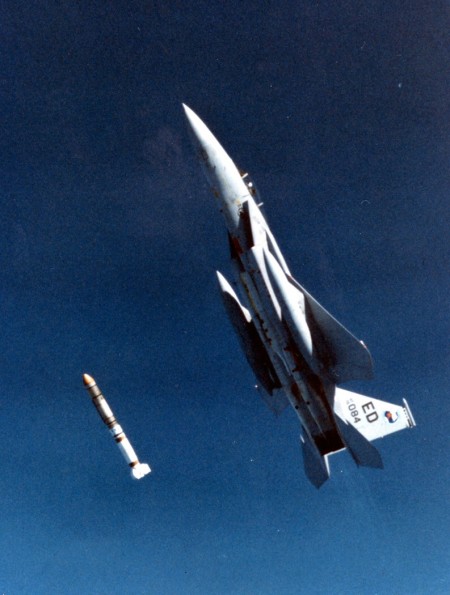
Twenty-eight years ago this month (September), the USAF/LTV ASM-135 anti-satellite missile successfully intercepted a target satellite orbiting 300 nautical miles above the Earth. The test was the first and only time that an aircraft-launched missile successfully engaged and destroyed an orbiting spacecraft.
The United States began testing anti-satellite missiles in the late 1950′s. These and subsequent vehicles used nuclear warheads to destroy orbiting satellites. A serious disadvantage of this approach was that a nuclear detonation intended to destroy an adversary satellite will likely damage nearby friendly satellites as well.
By the mid 1970′s, the favored anti-satellite (ASAT) approach had changed from nuclear detonation to kinetic kill. This latter approach required the interceptor to directly hit the target. The 15,000-mph closing velocity provided enough kinetic energy to totally destroy the target. Thus, no warhead was required.
The decision to proceed with development and deployment of a US kinetic kill weapon was made by President Jimmy Carter in 1978. Carter’s decision came in the aftermath of the Soviet Union’s successful demonstration of an orbital anti-satellite system.
LTV Aerospace was awarded a contract in 1979 to develop the Air-Launched Miniature Vehicle (ALMV) for the USAF. The resulting anti-satellite missile (ASM) system was designated the ASM-135. The two-stage missile was to be air-launched by a USAF F-15A Eagle executing a zoom climb. In essence, the aircraft acted as the first stage of what was effectively a 3-stage vehicle.
The ASM-135 was 18-feet in length and 20-inches diameter. The 2,600-lb vehicle was launched from the centerline station of the host aircraft. The ASM consisted of a Boeing SRAM first stage and an LTV Altair 3 second stage. The vehicle’s payload was a 30-lb kinetic kill weapon known as the Miniature Homing Vehicle (MHV).
The ASM-135 was first tested in flight on Saturday, 21 January 1984. While successful, the missile did not carry a MHV. On Tuesday, 13 November 1984, a second ASM-135 test took place. Unfortunately, the missile failed when the MHV that it was carrying was aimed at a star that served as a virtual target. Engineers went to work to make the needed fixes.
In August of 1985, a decision was made by President Ronald Reagan to launch the next ASM-135 missile against an orbiting US satellite. The Solwind P78-1 satellite would serve as the target. Congress was subsequently notified by the Executive Branch regarding the intended mission.
The historic satellite takedown mission occurred on Friday, 13 September 1985. USAF F-15A (S/N 77-0084), stationed at Edwards Air Force Base, California and code-named Celestial Eagle, departed nearby Vandenberg Air Force Base carrying the ASM-135 test package. Major Wilbert D. Pearson was at the controls of the Celestial Eagle.
Flying over the Pacific Ocean at Mach 1.22, Pearson executed a 3.8-g pull to achieve a 65-degree inertial pitch angle in a zoom climb. As the aircraft passed through 38,000-feet at Mach 0.93, the ASM-135 was launched at a point 200 miles west of Vandenberg. Both stages fired properly and the MHV intercepted the Solwind P78-1 satellite within 6-inches of the aim point. The 2,000-lb satellite was obliterated.
In the aftermath of the stunningly successful takedown of the Solwind P78-1 satellite, USAF was primed to continue testing the ASM-135 and then introduce it into the inventory. Plans called for upwards of 112 ASM-135 rounds to be flown on F-15A aircraft stationed at McChord AFB in Washington state and Langley AFB in Virginia. However, such was not to be.
Even before the vehicle flew, the United States Congress acted to increasingly restrict the ASM-135 effort. A ban on using the ASM-135 against a space target was put into effect in December 1985. Although USAF actually conducted successful additional ASM-135 flight tests against celestial virtual targets in 1986, the death knell for the program had been sounded.
In the final analysis, a combination of US-Soviet treaty concerns, tepid USAF support and escalating costs killed the ASM-135 anti-satellite effort. The Reagan Administration formally cancelled the program in 1988.
While the ASM-135 effort was relatively short-lived, the technology that it spawned has propagated to similar applications. Indeed, today’s premier exoatmospheric hit-to-kill interceptor, the United States Navy SM-3 Block IA anti-ballistic missile, is a beneficiary of ASM-135 homing guidance, intercept trajectory and kinetic kill technologies.






